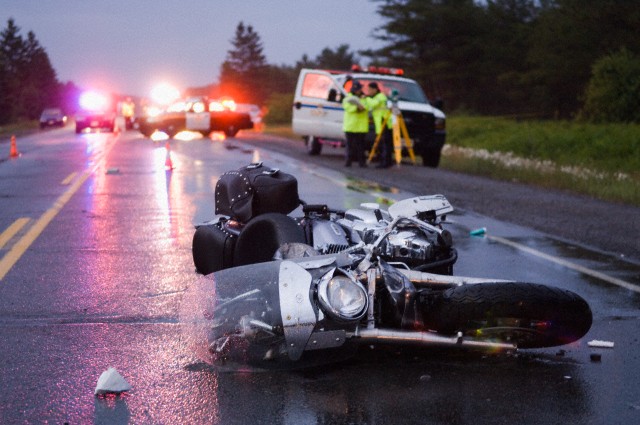Fatal Accidents Raise Isssue of Mandatory Motorcycle Helmet Law in CT
/
Since the beginning of June, motorcycles have been responsible for three deaths in the Fairfield County according to the Greenwich Time -- two in New Milford and one in Danbury -- as well as several injuries. The paper reported that “the recent fatalities have thrown long-standing debates over Connecticut's partial motorcycle helmet laws into a new light, prompting questions as to the efficacy of helmets and the future of statewide regulations requiring their use.”
In one recent incident – where the rider survived – the Time reported that “the bike burst into flames shortly after it collided with oncoming traffic, and its rider was thrown nearly 10 feet into the street.”
A report by consumerreports.org last month indicated that “in 2010, 98 percent of motorcyclists riding in states with helmet laws were wearing them. In states without the laws, helmet use was just 48 percent.” The Insurance Institute for Highway Safety reports that:
- Laws requiring all motorcyclists to wear a helmet are in place in 19 states (including New York, New Jersey and Massachusetts) and the District of Columbia
- Laws requiring only some motorcyclists to wear a helmet are in place in 28 states (including Connecticut, which requires helmets be worn by individuals 17 and under)
- There is no motorcycle helmet use law in 3 states (Illinois, Iowa, and New Hampshire)
National Highway Traffic Safety  Administration research shows riders who wear helmets are three times less likely to suffer brain trauma than those without them. According to a 2012 study released by the Centers for Disease Prevention and Control, motorcyclists accounted for 12 percent of motor vehicle fatalities in 2010, despite making up less than 1 percent of vehicle miles traveled, the Time reported.
Administration research shows riders who wear helmets are three times less likely to suffer brain trauma than those without them. According to a 2012 study released by the Centers for Disease Prevention and Control, motorcyclists accounted for 12 percent of motor vehicle fatalities in 2010, despite making up less than 1 percent of vehicle miles traveled, the Time reported.
Motorcycle helmets have not been uniformly required in decades. In 1967, to increase motorcycle helmet use, the federal government required the states to enact helmet use laws in order to qualify for certain federal safety programs and highway construction funds. The federal incentive worked. By the early 1970s, almost all the states had universal motorcycle helmet laws.
Michigan was the first state to repeal its law in 1968, beginning a pattern of repeal, reenactment, and amendment of motorcycle helmet laws. In 1976, states successfully lobbied Congress to stop the Department of Transportation from assessing financial penalties on states without helmet laws. The Connecticut General Assembly overturned the universal helmet requirement here later that year. The state passed its partial helmet law in 1989, applying only to individuals age 17 and younger.
Two years ago, The Hartford Courant was among the voices urging the mandatory helmet law be reinstated:
“In 2007, the most recent year for which statistics are available, 36 motorcycle riders died in crashes in Connecticut. That number may seem small, but it's not. Per mile traveled, the number of deaths on motorcycles was 37 times the number of people killed in cars, says the Insurance Institute for Highway Safety. A common saying among those in the medical community is that motorcycles ought to be called "donorcycles," because so often the organs of dead bikers are used for transplants.”
A 2011 Yale School of Medicine report analyzing state crash data between 2001 and 2007 found that two-thirds of the 358 riders killed in motorcycle accidents had not been wearing helmets. In an editorial this week, the Greenwich Time noted that “the National Highway Traffic Safety Administration estimated that in 2008, helmets saved the lives of 1,829 motorcyclists, and that 822 who died that year would have survived if helmets had been worn.”
The higher risk of serious injury or death that comes with optional helmets may also translate into economic losses. NHTSA data reportedly suggests that projected reductions in fatalities stemming from universal helmet laws could translate into savings in service costs and household productivity of up to $1,200,000 per avoided fatality.
The Connecticut Motorcycle Riders Association (CMRA) , formed in 1980, opposes helmet requirements, as it has for more than three decades. In the organizations view, it is a matter of freedom of choice – whether or not to wear a helmet is a decision to be made by bikers, not government. It was that view that prevailed when the legislature changed the state’s mandatory helmet law in 1977. In 1980, motorcyclists rallied in unprecedented numbers in Connecticut when a state legislator was involved in a motor vehicle accident in which a motorcyclist was killed.
Since then, the issue has been raised unsuccessfully at the state Legislature in bills or amendments 11 times. The CMRA website said, regarding the 2013 session, that “we are able to say that we have not had to fight any helmet laws this year,” and indicated that “we have repeatedly defeated attempts to reinstate the mandatory helmet law for adult motorcycle riders.” The issue has not been considered since 2005, according to the Time. The CMRA website also includes this tagline: “Let Those Who Ride Still Decide.” The organization has supported the creation of a self-funded rider education program and pushed for the adoption of a more comprehensive motorcycle license test throughout the state, the website points out.






























